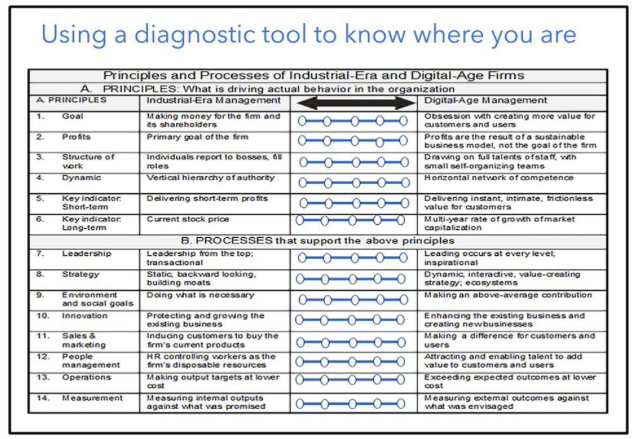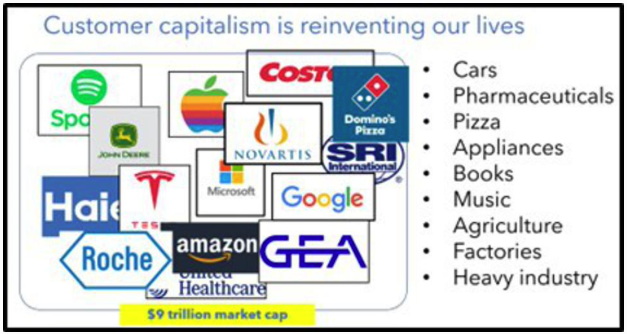Let’s face it. The age of agile has not arrived. The twenty-year effort to persuade large corporations to become Agile enterprises has largely failed. We need a new approach. Instead of trying to persuade big firms to embrace Agile, let’s raise our sights. Let’s get clear on what we really need: to take over, and in effect reinvent, the concept of management itself.
The Baggage Of Agile
After more than twenty years of effort, Agile itself has acquired baggage that gets in the way of “Agile enterprises” ever becoming a fully winning idea in business. The baggage is multi-faceted:
- Agile is still to some extent imprisoned in its origins as something happening in the firm’s basement among software developers and their unintelligible computer codings, in which the C-suite had no larger role than it had in the supervision of the firm’s plumbing or its electrical system.
- There is a great deal of fake agile, or “agile in name only”. The Agile label may be applied to practices that are no different from industrial era management—a focus on making money, individuals reporting to bosses, steep hierarchies of authority, innovation that is limited to improving existing products, HR that is control-minded, budgeting which is about battles among the resources for silos, and so on.
- Agile has sometimes become a pretext for the creation of sweatshops that use agile practices to increase the pressure on employees.
- The multiple flavors of Agile are also problematic. The efforts of scores of individual agilists and consultants to promote their particular flavor and terminology of Agile over all others has created a confusing cacophony.
- Paradoxically, the passion with which software developers advocate agile can set traditional managers’ teeth on edge. The issues are partly social: it’s as if the servants have forgotten their place and are trying to take over the chateau.
Some Recent Takes
A brace of insightful comments on LinkedIn this week underlined these problems:
- Chen Gongyuan: “Indeed, according to the practice of contacting customers: 1) I only see agile teams, but few organizations are agile. 2) Executives and management bureaucratically believe that agile is a team executive level issue, not a cultural and organizational issue
- Marc Lustig: “The problem is only to be solved when the enterprise identity moves beyond doing agile into the space of awareness. this happens when the commercial narrative is replaced with meaning that comes as a reflection of awareness.
- Luis Figueroa Gonzalez: “Organizations tend to fall into the traditional culture of doing things and end up impacting creativity and innovation.”
- Carl Weller: “Agile A.K.A ‘Feature Factories’, often created by an obsession with cadence/output rather than outcome. We didn’t do ourselves any favors with “Twice the work in half the time” (yes, a real book by one of the founders of Scrum). And made worse by ‘transformations’ that focus on organizing for delivery rather than understanding value…. Backlog comes into existance or is maintained (other than a bland comment about maximising ROI). If Agile is to make good on its promise, we really need to focus on product management.. no point helping teams deliver the wrong thing faster…”
- John Alger: “Agile for many has simply become a ‘management’ of a Backlog of work that isn't being Done!”
- Wolfgang Hilpert: “Indeed - I have observed a pattern where executive leaders that misunderstand agile principles and values try to "enforce" agile as the "broom to sweep up engineering". I have never seen anything good coming out of such an effort though.”
- The Department of Defense has noted various flaws in Agile implementations, including: (a) Software developers not talking to users (b) Meeting requirements more important than getting something useful to the field quickly (c) Stakeholders acting “more-or-less autonomously” (e.g. it’s not my job); (d) Manual processes are tolerated in situations when automation is possible
Find more insights about this theme in Steve Denning's new book: Reinventing Capitalism in the Digital Age

Reinventing The Very Concept Of Management
So let’s raise our sights. Let’s stop fighting the little battle to win acceptance of the label, “Agile.” Instead let’s fight and win the all-important war of getting the substance of Agile incorporated in the reinvention of the very concept of management itself.
Let’s identify the practices of industrial-era management and label them as “obsolete” and show why the constitute a disease that must be eradicated. Then let’s re-imagine the very concept of management itself.
That begins by taking to heart Peter Drucker’s 1954 insight, “There is only one valid purpose of a firm—to create customers.” It means re-conceiving management comprehensively in a way that liberates the entrepreneurial spirit, and thereby generating innovation, engagement, and improved productivity. Happily, this fundamentally different way of running a company is already well under way in the most financially successful firms included in Figure 2.
These firms have embraced a radically different set of principles:
- The goal of the firm is to create value for customers, along with a business model that generates profits as a result;
- The firm mostly deploys team-based arrangements;
- Instead of starting from what the firm can produce that might be sold to customers, firms work backwards from what customers need and then figure out how that might be delivered in a sustainable way.
- Instead of limiting themselves to what the firm itself can provide, the firm often mobilizes other firms to help meet user needs.
- Instead of the steep hierarchies of authority of industrial era-firms, digital firms tend to be organized in horizontal networks of competence.
Once these principles are in place, the firm can embrace processes that are also the opposite of industrial-era management.
- Leadership now occurs at every level, not just the top;
- Strategy is dynamic, interactive, and value-creating;
- Innovation enhances existing businesses and creates new businesses;
- Sales and marketing are now about making a difference for customers and users;
- HR is about attracting and enabling talent;
- Operations is about exceeding expected outcomes at lower cost, not just outputs;
- Budgeting is driven by strategy.
The convergence among the most financially successful firms towards this pattern of principles and processes is striking as shown in Figure 2. And note that these principles and processes are the opposite of the industrial-era firm, as shown in the diagnostic tool in Figure 1 .

Figure 1: Diagnostic tool to know where you are in management, by STEVE DENNING
Now we know the way, and we know the firms that are pursuing it, as shown in Figure 2, we can get on with winning the war to reinvent management.

Figure 2: Logos of firms pursuing customer capitalism, by STEVE DENNING
This article was written by Steve Denning to Forbes, on December 4th of 2022. You can find the original article here.